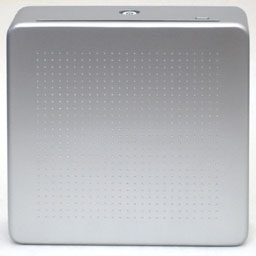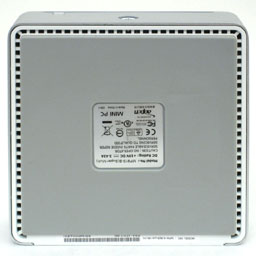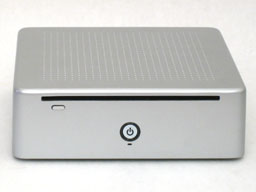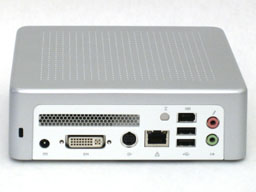Updated: AOpen MiniPC – Imitation is the Sincerest Form of Flattery
by Jarred Walton on March 3, 2006 12:05 AM EST- Posted in
- Systems
Appearance and System Specifications
To say that the AOpen MiniPC looks similar to the Mac Mini is an understatement. AOpen's own product marketing material contains numerous photographs comparing the two. Not everyone thinks that tiny PCs are cool looking or even necessary, but for those who do, the AOpen MiniPC is a very nice looking unit. Depending on where you purchase the MiniPC, you can find them in a variety of colors. Black, white, and silver are the most common, and the unit that we received is silver.
Other than the rear ports and the glowing blue power/HDD lights on the front, the case is a uniform silver. Also found on the front of the unit is the slot-load optical drive access and the accompanying eject button. The top has a grid of small indentations to add a bit of visual flare, while the sides and front are unadorned brushed aluminum. The bottom of the case has a rubberized non-slip pad with venting around the edges and a sticker containing product details, and that's about it. The case is, of course, very small, and you could easily hide it from view if desired, just like the Mac Mini. Technically, the MiniPC is slightly smaller than the Mac Mini (by about .5" in height), but basically, the system size is a tie.
One item that needs to be pointed out is the choice of interface. There are no legacy ports on the system; other than video and audio connections, the only interface for input devices and other components is provided by two USB 2.0 ports. Only two? That's right: if you want more than two devices, you're going to need a USB hub of some form. In fact, since you're going to use a mouse and keyboard for at least one port, a USB hub is almost required for expansion. You might try getting a keyboard with a couple of USB ports, but most likely, they will be USB 1.1, so you won't want to use them for high bandwidth devices. For testing, a Logitech Bluetooth keyboard and mouse combo was used, so that did leave a spare USB port. If you want to do anything more with the MiniPC, grab a powered USB 2.0 hub with at least four ports; they typically cost around $10 to $30, so it's not a major expense.
The Realtek ALC655 audio chip in the unit is capable of 5.1 sound, but apparently lack of room for the audio ports leaves only a speaker/headphone jack and a microphone jack. That should allow for up to 4.1 sound, using the microphone port for the rear/side speakers, but most users will either want 5.1 or 2.1 so the inclusion of only two audio jacks is a definite limitation. The unoccupied spot to the left of the USB/Firewire port is for the WiFi antenna, and it seems like AOpen could have added a third audio jack without too much difficulty, as there is still a bit of open space on the back plate. To the left of the plate you can see the exhaust port for the CPU HSF, and along the bottom are the DVI port, TV-out, LAN, and power sockets.
The TV-out takes an "octopus" adapter that splits the output into S-VIDEO, Component, or Composite, and a DVI to VGA adapter is included in the package. Both the component and DVI connections were tested with an HDTV, and the component was found to be preferable (as the DVI port would lose resolution settings between reboots). Notably lacking is support for S/PDIF output and legacy PS/2 ports for the keyboard and mouse. The audio overall is the weakest link, but the video aspects do help make up for it.
While the size and appearance may be similar to the Mac Mini, the insides are quite different. In typical Wintel fashion, AOpen has cloned the original Mac Mini with a system that is going to be faster in nearly every area. Here are the specifications.
If you're looking for a screaming fast computer, this isn't it. If you want to play a lot of games, once again, you're barking up the wrong tree. Taking all of the functionality in your standard computer and compressing it into a size that's about as big as your typical 5.25" DVD ROM drive requires some compromises. You get integrated graphics, a 2.5" hard drive, DVD burner, a processor and memory... and that's really about it. There is an option to have a WiFi card installed as well. The good news is that there are plenty of applications that don't require anything more than those specs.
One item that we have to clarify is that the system we received came with a Pentium M 740 (1.733 GHz Dothan) processor, and most of the online models as well as AOpen's documentation list the Pentium M 740 as the standard "high-end" processor. However, it appears that the system is capable of running faster CPUs, as there are a few European sites selling the MP915 with up to a Pentium M 760 (2.0 GHz). We didn't encounter any heat-related issues during testing, so other than cost there shouldn't be any reason for the MiniPC to not support the top Pentium M chips.
To say that the AOpen MiniPC looks similar to the Mac Mini is an understatement. AOpen's own product marketing material contains numerous photographs comparing the two. Not everyone thinks that tiny PCs are cool looking or even necessary, but for those who do, the AOpen MiniPC is a very nice looking unit. Depending on where you purchase the MiniPC, you can find them in a variety of colors. Black, white, and silver are the most common, and the unit that we received is silver.
Other than the rear ports and the glowing blue power/HDD lights on the front, the case is a uniform silver. Also found on the front of the unit is the slot-load optical drive access and the accompanying eject button. The top has a grid of small indentations to add a bit of visual flare, while the sides and front are unadorned brushed aluminum. The bottom of the case has a rubberized non-slip pad with venting around the edges and a sticker containing product details, and that's about it. The case is, of course, very small, and you could easily hide it from view if desired, just like the Mac Mini. Technically, the MiniPC is slightly smaller than the Mac Mini (by about .5" in height), but basically, the system size is a tie.
 |
 |
| Click on images to enlarge. | |
One item that needs to be pointed out is the choice of interface. There are no legacy ports on the system; other than video and audio connections, the only interface for input devices and other components is provided by two USB 2.0 ports. Only two? That's right: if you want more than two devices, you're going to need a USB hub of some form. In fact, since you're going to use a mouse and keyboard for at least one port, a USB hub is almost required for expansion. You might try getting a keyboard with a couple of USB ports, but most likely, they will be USB 1.1, so you won't want to use them for high bandwidth devices. For testing, a Logitech Bluetooth keyboard and mouse combo was used, so that did leave a spare USB port. If you want to do anything more with the MiniPC, grab a powered USB 2.0 hub with at least four ports; they typically cost around $10 to $30, so it's not a major expense.
The Realtek ALC655 audio chip in the unit is capable of 5.1 sound, but apparently lack of room for the audio ports leaves only a speaker/headphone jack and a microphone jack. That should allow for up to 4.1 sound, using the microphone port for the rear/side speakers, but most users will either want 5.1 or 2.1 so the inclusion of only two audio jacks is a definite limitation. The unoccupied spot to the left of the USB/Firewire port is for the WiFi antenna, and it seems like AOpen could have added a third audio jack without too much difficulty, as there is still a bit of open space on the back plate. To the left of the plate you can see the exhaust port for the CPU HSF, and along the bottom are the DVI port, TV-out, LAN, and power sockets.
The TV-out takes an "octopus" adapter that splits the output into S-VIDEO, Component, or Composite, and a DVI to VGA adapter is included in the package. Both the component and DVI connections were tested with an HDTV, and the component was found to be preferable (as the DVI port would lose resolution settings between reboots). Notably lacking is support for S/PDIF output and legacy PS/2 ports for the keyboard and mouse. The audio overall is the weakest link, but the video aspects do help make up for it.
While the size and appearance may be similar to the Mac Mini, the insides are quite different. In typical Wintel fashion, AOpen has cloned the original Mac Mini with a system that is going to be faster in nearly every area. Here are the specifications.
| AOpen MiniPC MP915 | |
| Motherboard: | AOpen propietary 915GM+ICH6M |
| Processor: | Intel socket 479 (Celeron M to Pentium M 740) |
| RAM: | 1 X DDR2 SO-DIMM (Maximum 1GB of RAM) |
| Hard Drive: | 2.5" PATA Notebook HDD |
| Graphics: | 915GM (Intel GMA900) |
| Optical Drive: | Slim CD/DVD slot load |
| Expansion Slots: | 1 X Mini-PCI (for WiFi) |
| Audio: | Realtek ALC655 AC'97 2CH (Speaker/Headphones + Microphone) |
| Power Suply: | 65W (19V, 3.5A) External Adapter Internal connections from motherboard to HDD and ODD |
| Front Ports: | None. Power Button, HDD Activity LED, ODD Eject Button |
| Rear Ports: | 2 X USB2.0 2 X 3.5mm Audio (speakers and microphone) LAN (GbE) 1 X DVI-D and 1 X TV-Out (S-VIDEO, Composite, Component) 1 X Optional WiFi Antenna |
If you're looking for a screaming fast computer, this isn't it. If you want to play a lot of games, once again, you're barking up the wrong tree. Taking all of the functionality in your standard computer and compressing it into a size that's about as big as your typical 5.25" DVD ROM drive requires some compromises. You get integrated graphics, a 2.5" hard drive, DVD burner, a processor and memory... and that's really about it. There is an option to have a WiFi card installed as well. The good news is that there are plenty of applications that don't require anything more than those specs.
One item that we have to clarify is that the system we received came with a Pentium M 740 (1.733 GHz Dothan) processor, and most of the online models as well as AOpen's documentation list the Pentium M 740 as the standard "high-end" processor. However, it appears that the system is capable of running faster CPUs, as there are a few European sites selling the MP915 with up to a Pentium M 760 (2.0 GHz). We didn't encounter any heat-related issues during testing, so other than cost there shouldn't be any reason for the MiniPC to not support the top Pentium M chips.












54 Comments
View All Comments
bldckstark - Saturday, March 4, 2006 - link
Maybe lots and lots of people do care, but I couldn't give a crap less about what the back panel of any computer looks like. Maybe someone could tell me why they do.As for it not looking better, that would be a subjective opinion.
Snuffalufagus - Saturday, March 4, 2006 - link
Just for the sake of the 'Company that sucks' copied the 'company that had the idea first' argument, what, in a low profile box, of the same approximate dimensions, could they have done to make people not claim it was a duplicate? Change the color? Change the rubber foot pads? Revert back to PS2 connections? This idea that one company shouldn't build off the strengths found in another is stupid, and would ultimately lead to stagnation if no company learned from the mistakes and successes of another.Copying form doesn't really mean shit as far as one being better. Hell, I think the Mac Mini is a piece of crap due to it's lack of versatility, but now its being praised for that capability now that this new piece of crap is out (i.e. two vs. one mem slot).
FWIW - this wasn't purely a response to your post, it was just a covenient place to put the comment.
JarredWalton - Saturday, March 4, 2006 - link
I couldn't care less about copying. Whoever does it best gets my vote. The lack of versatility really isn't a major lack, though. The only things the MiniPC can't do are:1) Gaming (other than old games or 2D stuff)
2) High-end audio (without USB add-on)
3) TV Tuner stuff
4) High performance computing.
Most people don't need any of those things. Given that it's small, reasonably fast, and reasonably quiet (and all of the above pretty much applies to the Mac Minis as well), these things could be great for the less power hungry people.
Unfortunately, my mom still can't use a computer worth a darn, so reducing hardware complexity isn't going to help her with the software side. (And please don't bother suggesting OSX; she really is clueless about computers, and we're just happy when she can manage to read/write email!)
Herrterror - Friday, March 3, 2006 - link
yeah, poor Apple. They wanted to introduce Sloanism to the computer industry and ended up losing out to copycats.kmmatney - Friday, March 3, 2006 - link
The price of this has to be at least lower than a laptop. You can get a decent laptop for the same price, with a built-in LCD and Keyboard, and a lot more IO. You can still just hook up a Keyboard and Monitor with a laptop, as I do at work everyday, plus you get portability if you need it.JarredWalton - Saturday, March 4, 2006 - link
A few things laptops are generally lacking:1) DVI output
2) Component output
3) Anything more than 2.1 audio output
So, the HDTV connections of the MiniPC are definitely something to think about. Component out is probably the best way to guarantee a system can function as an HTPC (though the whole HDCP issue is looming on the horizon....) Also, these systems (Mac Mini/MiniPC) are both smaller than a laptop - why have a screen if you're not going to use it, right? But I do agree that the price needs to at least match an equivalent laptop.
WhoBeDaPlaya - Monday, March 6, 2006 - link
The Audigy 2 ZS PCMCIA has #3 covered ;)Been using it with my trusty 'ol eMachines m6805 since late 2004.
Snuffalufagus - Friday, March 3, 2006 - link
but fill a particular niche market that's appealing for certain applications.joey2264 - Friday, March 3, 2006 - link
I was just thinking ... what if they did an end run around apple by making this a dvr? Apple's stupid allegiance with the content providers practically guarantees they will never put out a true dvr, but aopen obviously has no such qualms. They need to make a version with core duo, decent tv tuner built-in(preferably ati 550 pro if that was possible), 2 ram slots, at least 4 usb ports, and spdif (basically the same ports as the mac mini + a tv in).How cool would that be? It might even put the pressure on apple to produce a dvr of their own.
joey2264 - Friday, March 3, 2006 - link
I think the key thing here, the reason why Apple can charge such a low price, is because you are not paying for the os with the mac mini. This price advantage does not factor itself into every other Apple product, because of Apple's crazy profit margins. But this is the one product where they are willing to make little to no profit, and so, who whodathunkit, they are price competitive. If only they would take a similar strategy (although obviously not to this extreme) with their other products).The only way the wintel world could compete is if Microsoft designed a mini pc of their own, or gave it away to an extra special favorite manufacturer of theirs.